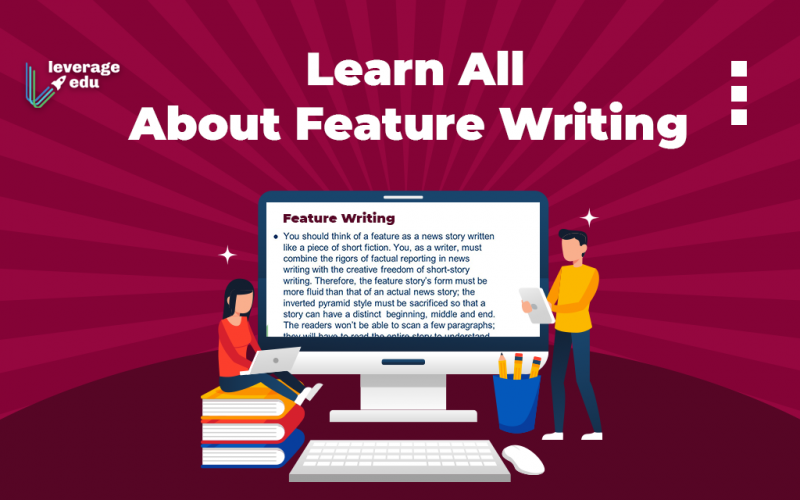Feature Writing is a literary and critically recognised form of writing in Journalism. It involves writing featured articles on trending topics, great personalities and relevant issues. This form of writing is generally longer than a specific news story and more informative. Feature writings are used extensively in magazines, newspapers and online media. It covers a story in great depth and is intended to captivate the audience’s attention to a specific cause by looking at the story from a different angle. Did you know there is a Pulitzer Prize for Feature Writing? Keep reading to learn more about feature writing and how to craft the best feature.
This Blog Includes:
What is the Difference Between a News Story and a Feature Story?
People are often confused between a news story and a feature. Here are some basic differences between the two:
- While a news story usually covers recent or breaking news, feature writing can be issue-specific and might not be recent.
- A news story summarises the story whereas a feature focuses on anecdotal references.
- A feature contains many angles and sources whereas on the contrary, a news story general is from a single source or angle.
- If we compare the structure of the forms of writing, the news story follows an inverted pyramid structure while feature writing has a flexible structure and can take a linear/non-linear scale. The conclusion forms a very important part of the feature.
For instance, recent news can be covered in a news feature and it can abandon the inverted pyramid structure to cover a human interest story using more detail and emotion.
Also Read: How to Write Dialogues?
Feature Writing – the APPLAUSE Formula
According to journalistic theories, a feature writing story must follow the APPLAUSE Formula where each letter represents:
A – Appeal
P – Plain Facts
P – Personalities
L – Logic
A – Action
U – Universal
S – Significance
E – Energy
Must Read: How to Become a Ghostwriter?
Different Types of Feature Writing
According to The Universal Journalist written by the British journalist David Randall and a critically acknowledged masterpiece on Journalism elaborates on the following different types of feature stories:
- Colour Piece: A feature story that essentially tries to inform readers regarding a particular theme or subject.
- Fly on the Wall: A feature story that is conceived and narrated unobtrusively and mostly without the explicit permission of the subjects.
- Behind the Scenes: A feature story that shifts its focus from the principal event to the background and narrates an interesting tale.
- In Disguise: A feature story that is told while the storyteller is a part of the event.
- Interview: A feature story that develops itself around questions asked to a respondent, who is usually in a place of prominence.
- Profile: A feature story that is based on the exploits of a particular eminent person with or without his/ her interview.
- How-To: A feature story that is dependent on research and helps readers in solving a problem or deciphering a scenario.
- Fact Box/ Chronology: A feature story that provides plain and simple facts mostly in chronological order.
- Backgrounder/ A History of: A feature story that provides detailed information.
- Full Texts: A feature story that is nothing but extracts from a book or transcripts of an interview.
- Testimony: A feature story that is the first-person account of an individual.
- Analysis: A feature story that scholarly analyzes an event.
- Vox Pop/ Expert Roundup: A feature story that accumulates opinions from the general citizenry and thought leaders concerning a subject.
- Opinion Poll: A feature story that conducts research on opinions and presents a generalized summary of the accumulated opinions.
- Review: A feature story that reviews a work of art and presents a generalized opinion.
There is no set format for feature writing. It generally involves stories that play an extremely critical role in building opinions and inciting actions. Features are extensively used for advocacy, knowledge generation and raising awareness on issues.
Improve your English with Leverage Live! Sign up for a Demo Session today!
Style and Objective of Feature Writing
As discussed, a feature story generally represents a new item through a narrative story and uses plot and story characters. The content used in feature writing is not fictional, It heavily relies on realism, subjectivity and creativity. The purpose of Feature Writing is to attempt to connect emotionally with the readers. It serves the purpose of entertaining the readers while informing them. They are however less objective than straight news.
Feature stories are also not time-sensitive and are written in an active style emphasising mainly entertaining prose. A feature story normally presents newsworthy events or takes a relevant cause that has been in the media for a while. For instance, the award-winning feature writing piece, “When can we really rest?” by Nadja Drost talks about the dangerous journey undertaken by migrants crossing the Colombia-Panama border to reach the US.
To understand Feature stories more, let us see with a slide given below:
Sample
Related Blogs:
| Notice Writing for Class 8: Tips and Format | Speech Writing |
| Story Writing Format for Class 9 to 12 | How to Write a Letter: Letter Writing Types and Examples |
| Advertisement Writing | Creative Writing Topics |
Feature writing is a creative as well as an informative tool of writing; it’s designed to raise awareness and bring notice to relevant issues around the world. Want to pursue a career in writing and journalism? Contact our experts at Leverage Edu and get the best advice on colleges, courses and the best countries!

 One app for all your study abroad needs
One app for all your study abroad needs





















 45,000+ students realised their study abroad dream with us. Take the first step today.
45,000+ students realised their study abroad dream with us. Take the first step today.

